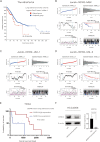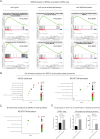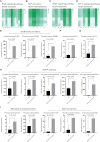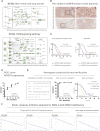Multiomics analysis revealed the mechanisms related to the enhancement of proliferation, metastasis and EGFR-TKI resistance in EGFR-mutant LUAD with ARID1A deficiency
- PMID: 36869329
- PMCID: PMC9985251
- DOI: 10.1186/s12964-023-01065-9
Multiomics analysis revealed the mechanisms related to the enhancement of proliferation, metastasis and EGFR-TKI resistance in EGFR-mutant LUAD with ARID1A deficiency
Abstract
Introduction: Dysregulated ARID1A expression is frequently detected in lung adenocarcinoma (LUAD) and mediates significant changes in cancer behaviors and a poor prognosis. ARID1A deficiency in LUAD enhances proliferation and metastasis, which could be induced by activation of the Akt signaling pathway. However, no further exploration of the mechanisms has been performed.
Methods: Lentivirus was used for the establishment of the ARID1A knockdown (ARID1A-KD) cell line. MTS and migration/invasion assays were used to examine changes in cell behaviors. RNA-seq and proteomics methods were applied. ARID1A expression in tissue samples was determined by IHC. R software was used to construct a nomogram.
Results: ARID1A KD significantly promoted the cell cycle and accelerated cell division. In addition, ARID1A KD increased the phosphorylation level of a series of oncogenic proteins, such as EGFR, ErbB2 and RAF1, activated the corresponding pathways and resulted in disease progression. In addition, the bypass activation of the ErbB pathway, the activation of the VEGF pathway and the expression level changes in epithelial-mesenchymal transformation biomarkers induced by ARID1A KD contributed to the insensitivity to EGFR-TKIs. The relationship between ARID1A and the sensitivity to EGFR-TKIs was also determined using tissue samples from LUAD patients.
Conclusion: Loss of ARID1A expression influences the cell cycle, accelerates cell division, and promotes metastasis. EGFR-mutant LUAD patients with low ARID1A expression had poor overall survival. In addition, low ARID1A expression was associated with a poor prognosis in EGFR-mutant LUAD patients who received first-generation EGFR-TKI treatment. Video abstract.
Keywords: ARID1A; Cell cycle; EGFR-TKI resistance; EGFR-mutant LUAD; Multiomics analysis.
© 2023. The Author(s).
Conflict of interest statement
The authors declare no conflicts of interest.
Figures






Similar articles
-
ARID1A deficiency reverses the response to anti-PD(L)1 therapy in EGFR-mutant lung adenocarcinoma by enhancing autophagy-inhibited type I interferon production.Cell Commun Signal. 2022 Oct 13;20(1):156. doi: 10.1186/s12964-022-00958-5. Cell Commun Signal. 2022. PMID: 36229854 Free PMC article.
-
Loss of ARID1A expression promotes lung adenocarcinoma metastasis and predicts a poor prognosis.Cell Oncol (Dordr). 2021 Oct;44(5):1019-1034. doi: 10.1007/s13402-021-00616-x. Epub 2021 Jun 9. Cell Oncol (Dordr). 2021. PMID: 34109546
-
ARID1A deficiency attenuates the response to EGFR-TKI treatment in lung adenocarcinoma.Front Pharmacol. 2025 May 20;16:1582005. doi: 10.3389/fphar.2025.1582005. eCollection 2025. Front Pharmacol. 2025. PMID: 40463905 Free PMC article.
-
ARID1A serves as a receivable biomarker for the resistance to EGFR-TKIs in non-small cell lung cancer.Mol Med. 2021 Oct 29;27(1):138. doi: 10.1186/s10020-021-00400-5. Mol Med. 2021. PMID: 34715776 Free PMC article. Review.
-
ARID1A mutations in lung cancer: biology, prognostic role, and therapeutic implications.Trends Mol Med. 2023 Aug;29(8):646-658. doi: 10.1016/j.molmed.2023.04.005. Epub 2023 May 11. Trends Mol Med. 2023. PMID: 37179132 Review.
Cited by
-
Targeting MDM2 in malignancies is a promising strategy for overcoming resistance to anticancer immunotherapy.J Biomed Sci. 2024 Jan 29;31(1):17. doi: 10.1186/s12929-024-01004-x. J Biomed Sci. 2024. PMID: 38281981 Free PMC article. Review.
-
Advancements and applications of single-cell multi-omics techniques in cancer research: Unveiling heterogeneity and paving the way for precision therapeutics.Biochem Biophys Rep. 2023 Nov 29;37:101589. doi: 10.1016/j.bbrep.2023.101589. eCollection 2024 Mar. Biochem Biophys Rep. 2023. PMID: 38074997 Free PMC article. Review.
-
A cohort-based multi-omics identifies nuclear translocation of eIF5B /PD-L1/CD44 complex as the target to overcome Osimertinib resistance of ARID1A-deficient lung adenocarcinoma.Exp Hematol Oncol. 2025 Jan 7;14(1):3. doi: 10.1186/s40164-024-00594-4. Exp Hematol Oncol. 2025. PMID: 39773749 Free PMC article.
-
Drug-induced tolerant persisters in tumor: mechanism, vulnerability and perspective implication for clinical treatment.Mol Cancer. 2025 May 24;24(1):150. doi: 10.1186/s12943-025-02323-9. Mol Cancer. 2025. PMID: 40413503 Free PMC article. Review.
-
Advances in the study of the role of high-frequency mutant subunits of the SWI/SNF complex in tumors.Front Oncol. 2024 Dec 4;14:1463892. doi: 10.3389/fonc.2024.1463892. eCollection 2024. Front Oncol. 2024. PMID: 39697230 Free PMC article. Review.
References
-
- Allemani C, Matsuda T, Carlo VD, et al. Global surveillance of trends in cancer survival: analysis of individual records for 37,513,025 patients diagnosed with one of 18 cancers during 2000–2014 from 322 population-based registries in 71 countries (CONCORD-3) Lancet. 2018;391(10125):1023–1075. doi: 10.1016/S0140-6736(17)33326-3. - DOI - PMC - PubMed
Publication types
MeSH terms
Substances
LinkOut - more resources
Full Text Sources
Medical
Research Materials
Miscellaneous

